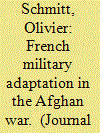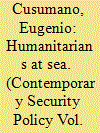| Srl | Item |
| 1 |
ID:
153052


|
|
|
|
|
| Summary/Abstract |
For some, a specific feature of the French armed forces' adaptation process in the adaptation process would be the capacity to look inward instead of outward in order to identify relevant solutions to tactical/doctrinal problems. This article questions such a narrative, and argues that the French armed forces are as quick as any to borrow from other countries’ experiences. In order to do so, this article introduces the concept of ‘selective emulation’, and compares the French and German military adaptation processes in Afghanistan. The article argues that there is indeed something distinctive about French military adaptation, but it is not what the fiercest defenders of the French ‘exceptionalism’ usually account for.
|
|
|
|
|
|
|
|
|
|
|
|
|
|
|
|
| 2 |
ID:
166613


|
|
|
|
|
| Summary/Abstract |
Between 2014 and 2017, no less than 10 different non-governmental organizations (NGOs) conducted maritime Search and Rescue (SAR) operations off the coast of Libya. By rescuing over 100,000 migrants in three years, these NGOs became the largest provider of SAR in the Mediterranean. The theory of institutionalism suggests that organizations conducting similar activities are likely to converge in a process of mimetic isomorphism, deliberately imitating one another to increase their effectiveness and cope with uncertainty. These 10 SAR NGOs, however, developed two different rescue models: While some rescued migrants and disembarked them in Italian ports, others only simply assisted those in distress until the arrival of another ship transporting them to land. They also cooperated with Italian and European authorities to different degrees. Why did SAR NGOs imitated many elements of existing non-governmental rescue models, but discarded some others? This article argues that differences in material capabilities and organizational role conceptions are crucial to explain why newer SAR NGOs have imitated most but not all of their predecessors’ policies, engaging in a process of “selective emulation.”
|
|
|
|
|
|
|
|
|
|
|
|
|
|
|
|